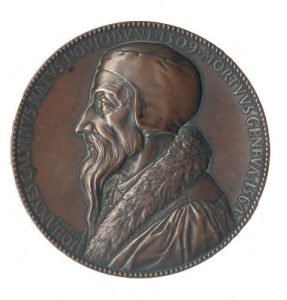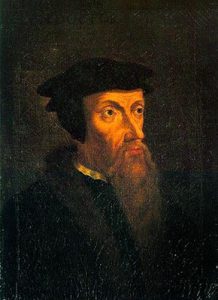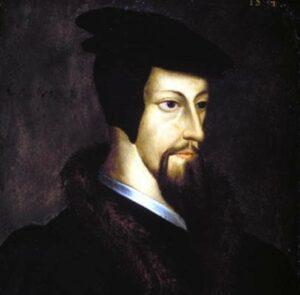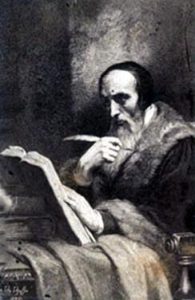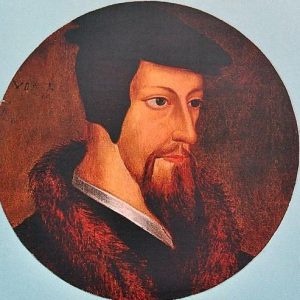The context of A Treatise about relics
Calvin spent at least three years in Basel and Strasburg ; then he returned to Geneva in 1541, where he was appointed pastor and was also involved with publishing. In the early 1540’s he showed signs of concern about the future of the Church and wanted above all to stabilize and consolidate the reformed community in Geneva. He also wanted to purify the Church of any potentially harmful influence capable of preventing the full glory of God from shining forth. (See the introduction of I. Backus’ edition). He had four texts published in 1543 :
- The defense of the doctrine of freewill in bondage : a polemical text directed against the catholic theologian Albert Pigge, in which Calvin asserted that man could only be saved if he trusted God completely.
- The Supplication and admonishment addressed to the Emperor, concerning Christianity and the reformation of the Church : this was an official text addressed to Charles Quint in which Calvin pleaded for a reform of the Church and an act of worship devoid of “human superstition”.
- A Short treatise showing the faithful how to conduct themselves when living amongst papists : this was a text for Protestants who lived in places where there were no reformed act of worship, warning them not to give in to “papist idolatry”.
- The Treatise about relics : another text for Protestants. Calvin tried to persuade Protestants not to follow this strange religious practice, which he attacked with fierce ridicule.
The satirical attack of false relics had been done before. But with the development of devotion moderna, it took on a new theological dimension : for example, Erasmus had a deep mistrust of this superstition. With the Reform Movement, a new antagonism emerged ; not only Calvin, but Luther too denounced this practice and the idolatry it encouraged, just when the Council of Trent declared that such a religious cult should be held in veneration. (See the introduction of O.Millet’s edition).
Calvin's success in publishing
Calvin’s Treatise about relics was highly successful from the start. At least ten editions were published in the XVIth century in French, Latin, German, English and Flemish. It was entered into the Index librorum prohibitorum of the Paris theology Faculty in 1543. The reasons for its instant success and also censorship were probably the ironical, apparently objective tone used to describe the relics in question. For example, Calvin mentioned 14 nails from the Cross !
The full title is A very useful notification of the great worth for Christianity of making an inventory of all the holy bodies and relics which are to be found in France, Germany, Spain and other kingdoms and countries. Even today, it is possible to consult original versions of this work in Paris, Aix-en-Provence, Geneva, Wolfenbüttel, Cambridge, etc. In Paris, the Bibliothèque Nationale has a copy of the 1601 edition. (Pontorson : J.de Fèvre, 88pages ; cote D2-4242(2). The library of the Société Historique du Protestantisme Français possesses 3 editions, respectively dated 1588 (but we do not know where it was published), 1599 (Geneva, P.de la Rovière) and 1601 (Pontorson : J de Fèvre). There are also in Paris several modern editions, including that of Olivier Millet (Calvin, Oeuvres choisies, Gallimard, 1995) and Irena Backus (Traité des reliques, Geneva, Labor et Fides, 2000).
It is this last edition which has been used for the extracts selected in this article. Here, we can catch a glimpse of Calvin’s ferocious satire. He shows us that there are by far too many relics (extract n°2), reminds us that there is no mention of them in the Bible (extract n°2), or denounces the fact that different “body parts” are scattered all over Europe (extract n°3). He argues from different points of view : legal, historical and theological. However, the general style of the Treaty, (which is in fact a long list of relics and where they can be found, the whole written with disarming honesty), has its place in the context of anti-catholic polemics.
A summary of the work
The Treatise about relics can be divided into two distinct parts. One part consists of the introduction, conclusion and several passages in which Calvin develops the argument that the relics are “untruthful”. The other part, the main body of the text, consists of a long list of relics and a description of their whereabouts.
In the part in which Calvin tries to dissuade protestants from following the cult of relics, he puts forward several arguments. Firstly, the word of Christ is preferable to his “shirts” or his “shoes”, it is indeed idolatry to worship these rather than God himself. What’s more, most relics are not mentioned in the Bible and would not have survived the several destructions of Jerusalem (for example the table of the Last Supper, in Rome). They have come into being after the 1st century so we can conclude that they are false (Saint Antony’s arm, in Geneva) or anachronistic (the dice of the Roman soldiers), or contradictory (the three foreskins of Christ, in Rome, Charroux and Hildesheim). He goes on to say that these relics only give rise to quarrels, both amongst the Christians of the West (the cross which appeared to Constantine could be found either in Brescia or else in Cortonna) and also the Eastern Churches (whose opinions on the physical remains of holy saints are probably more reliable than European hypotheses). Finally, there is the highly dangerous risk of transforming any mundane object into a holy relic (one can worship a brigand’s coat, a dog’s bone, the ring of a debauched woman), also the instruments of the Passion can be considered sacred : (the spear, the nails, the thorn, but also the stones used for inflicting the death of saint Stephen or the arrows used against Saint Sebastian).
The second part of this work consists of a vast panorama of holy relics throughout catholic Europe in the XVIth century. Calvin says that it is indeed a deep “forest”, from which it is difficult to find one’s way out ; this is why he recommends a methodical approach. First, concerning Christ : his teeth, hair, blood, cradle, the column against which he leant while arguing in the Temple, the wine jars of Cana, the bread, the cross, the shroud, Judas’ deniers, the crucified body with the beginnings of a beard or weeping eyes. Next, the Virgin Mary : her bones, hair, milk, clothing, belt, slipper and hair clips. Then later, Calvin goes on to speak about the saints who were with Jesus : Saint John the Baptist and pieces of his head, his jaw, his ear, his finger ; Saint Peter and his body, his head, his teeth, his brain, his episcopal pulpit ; saint Paul and his body, his shoulder, his bones, the chains with which he was held. Finally, Calvin writes more summarily about the relics of other saints : Thomas, Denis, Etienne, Laurent, Gervais, Protais, Pétronelle, Hélène, Hilaire, Honorat, Symphorien, etc. Several of them have so many relics that according to Calvin, it would be possible to reconstitute several human bodies ; Andrew, the two James’s, Philip, Simon, Ann, Lazarus, Madeleine, Sebastian, Anthony, etc.
The great battle of the nails" : Christ's passion (extract 1)
“And there is the great battle of the nails. I will mention those which have come to my notice(…) If the writers of old were speaking the truth, notably Theodoritus, historian of the early Church, Helen had one fitted into her son’s helmet and added the two others to her horse’s bit. But Saint Amboise does not give the same story : according to him, one was embedded in Constantine’s crown, another was made into a horse’s bit and the third was kept by Helen.
So over twelve hundred years ago, there were already uncertainties about what had become of the nails. In this day and age, what can one be sure of ? In Milan, they boast of having the nail which was embedded in the bit of Constantine’s horse. But Carpentras disagrees, saying that they own the nail themselves. But what saint Ambroise said was that the nail was not attached to the bit, but that the bit was actually made out of the nail. And this information does not fit in with what they say in Milan or Carpentras.
Then there is also one in Rome, Saint-Hélène, the same one is apparently also in the Eglise Sainte-Croix, another in Sienna another in Venice, two in Germany, one in Cologne, in the Trois-Maries, another in Trêves. In France there is one in the Sainte Chapelle in Paris, another with the Carmelites, another in Saint-Denis-en-France, one in Bourges, one in Tenaille one in Draguignan. That makes a total of fourteen” (…)
"If the Virgin Mary had been a cow" : the hair and milk of Mary (extract 2)
As for the Virgin Mary, because they assert that her body is no longer in the earth, they have no way of boasting that they have her bones. In fact, I think they would gladly have made people believe that she had had a body in order to fill a charnel house with her bones. So, out of vengeance, they made do with her hair and her milk, so as to have some part of her anatomy with which to make a relic. Mary’s hair can be found in Rome, Sainte-Marie-sus-Minerve, Saint-Salvador in Spain, Mâcon, Cluny, Noyers, Saint-Flour, Saint-Jaquerie and in several other places.
It is quite impossible to mention all the places in which her milk can be found. For example, in any small town or tiny convent where there are nuns or monks – in all of these places they show it to you, sometimes a lot, sometimes a little. Indeed, to have large pans full of it would appear shameful, but in order to better hide their deceitful behaviour, they display the precious liquid in a glass or crystalline container – in that way it is impossible to examine it closely. So much so that the Virgin would have found it difficult to produce so much, had she been a cow or a wet nurse.
What’s more, I wonder how this milk which one is shown has been collected and preserved for our time. Because in the Bible there is no mention of any such thing. We read that the shepherds adored Jesus Christ, that the wise men offered him their gifts, but it is not written that they bought him any milk. Saint Luke tells us that Simeon had predicted that the Virgin would have a child, but not that he asked her for any milk. Even if we only consider this point we do not have to put forward any other argument to prove that this madness is without reason or foundation (…)”.
"Let us remember saint Peter's brain" : the relics of the apostles (extract 3)
“Now it is the turn of the apostles. But as there are far too many of them if I put them all together and it could lead to confusion, let us take saint Peter and saint Paul on their own. Their bodies are in Rome, one half in Saint Peter’s Church, the other in Saint Paul’s Church. And they say that saint Sylvester weighed them in order to distribute the bodies in equal parts. Their two heads are both in Rome, in Saint-Jean de Latran and there is also, in this church one of saint Peter’s teeth.
After this, there appear to be bones everywhere : in Poitiers, there is the apostle’s jaw and beard, in Trêves, several bones belonging to both of them, in Argenton en Berry, saint Paul’s shoulder. And how does this come about ? The truth is, that wherever there is a church which bears their name, there you can be sure to find a relic. For example, the brain of saint Peter which was in the high altar of the church in this town. In fact, it was nothing more than a sponge stone and many bones belonging to horses or dogs were also said to have belonged to the apostles.
As for the body, there is more. In Saint-Salvador in Spain, there is a slipper, although I can not describe its shape or the material it is made of. But it is probably similar to the ones in Poitiers, made of satin embroidered with gold. Thus it is that the saint becomes elegant after his death, to compensate for the fact that he was poor during his lifetime. Seeing as the bishops nowadays are so well-dressed, when they wear their official papal robes, naturally they consider that it is only normal for the apostles to be as elegant as themselves.”


